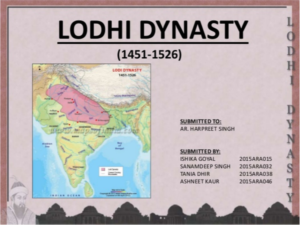The Lodi Dynasty Under Delhi Sultanate- History Notes
Overview of Lodi Dynasty Under Delhi Sultanate
There were 5 short-lived dynasties that framed the picturesque of the great Kingdom of Delhi Sultanate. The first three of which were of Turkish origin (Mameluk Dynasty, Khalji Dynasty & Tughlaq Dynasty), the fourth was the Sayyid Dynasty and the last was the Lodi Dynasty.
Here, we are going to get an overview of the last ruling power over the Delhi Sultanate – a Pashtun Dynasty is famously known as the Lodi Dynasty.
Read more: GREEN WALL OF INDIA, VERTICAL GARDEN, INSIGHTS
Read more: White Revolution in India: Important Facts & objectives

Who founded the Lodi Dynasty & when?
Bahlul Lodi founded the Lodi Dynasty which flourished its rule at the beginning of the middle of 15th century to the first quarter of the 16th century (i.e. 1451-1526).
Lodi dynasty came to rule by replacing the earlier ruling Sayyid Dynasty. On the invitation of the wazir (Hamid Khan) of the last ruler of Sayyid Dynasty– AlauddinAlam Shah, Bahlul Lodi came forward to take the charge of the army but later on, he acquired the throne of Delhi Sultanate by removing AlauddinAlam from power. Then onwards the Lodi’s dominated the upper Ganga valley and the Punjab region.
Bahlul Lodi and his rule (1451-1489)
· He annexed the Sharqi dynasty of Jaunpur (founded by Malik Sarwar) and appointed his son Barbak Shah as the Governor of Jaunpur.
· He issued a copper coin in Jaunpur
· To win the support of Afghan nobles, he declared himself as one of the Afghan peers, not the king.
· Finding himself in a weak position, Bahlul invited the Afghans of Roh to come to India so that they will get rid of the ignominy of poverty. And he can gain the ascendancy. On getting the farman, the Afghans of Roh came to join the service of Sultan Bahlul Lodi.
· This not only enabled Bahlul to defeat and vanish the rule of Sharqis but also it transformed the Muslim society in India, by making the Afghans numerous and an essential element, both in the South and North India.
· He has suppressed the Khokhar revolts.
· He also brought the rulers of Kalpi and Dholpur under his suzerainty
Sikandar Lodi and his rule (1489-1517)-
· He was the most important and powerful Lodi Sultan.
· He was a contemporary of Mahmud Begarha of Gujarat and Rana Sanga of Mewar.
· Sikandar’s real name was Nizam Khan and his mother was a Hindu.
· In 1504 AD, he shifted his capital from Delhi to Agra and constructed many mosques there.
· He was the king who abolished the duties on corn and promoted trade and commerce.
· He had composed many Persian verses under the pen name Gulrakhi.
· He has also introduced a new system of land measuring known as “Gazz-i-Sikandari”
· He re-annexed Bihar, Dholpur, Narwar and some parts of Gujarat and Nagor to Delhi Sultanate.
Ibrahim Lodi and His Rule (1517- 1526)
· He was Sikandar’s eldest son.
· Rana Sanga of Mewar defeated him in the battle of Khatoli in 1518 AD.
· The ruler of Gwalior gave shelter to Jalal Khan, the brother of Ibrahim, therefore he attacked and annexed Gwalior to his kingdom and murdered his brother.
· He was a fearful military leader therefore he was successful in keeping away the outsiders from his empire from about the whole of a decade.
· He was engaged in warfare with the Afghans and Mughals for most of his ruling period and was all the time protecting the Lodi Dynasty from collapsing.
· But it was in 1526; in the Battle of Panipat that Ibrahim Lodi was defeated which directly lead to the fall of the Lodi Dynasty.
· This very defeat of Ibrahim Lodi saw the end of Lodi Dynasty and beginning of the Mughal Empire in the country starting from Babur as the leading Mughal force
For more such informative articles stay tuned to OWN TV.
